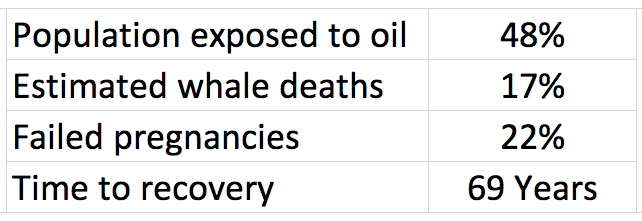NOAA Drops a Lifeline to Rare Gulf of Mexico Whale
Published by Ocean Conservancy
We received some welcome news this week about a rare subspecies of whale that lives exclusively in the Gulf of Mexico. NOAA has listed the Gulf of Mexico Bryde’s whale (pronounced BROO-dus) as endangered under the Endangered Species Act. With a shockingly low population estimate of merely 33 individuals, the Gulf population of Bryde’s whale is one the world’s most endangered marine mammals. We applaud NOAA’s decision to officially grant the whale this new protection.
In 2014, NOAA found that the resident population of Bryde’s whales in the Gulf is a unique subspecies, qualifying them for endangered status. The Gulf’s remaining Bryde’s whales (large-headed filter-feeders that are rarely seen) now live in a small area just off the coast of the Florida Panhandle.
Help us protect endangered species
Sign up to get the latest updates
This designation is a critical step toward recovery, because it triggers a road map for restoring the whale population to a healthy and self-sustaining level. These road maps, or recovery plans, identify the management actions necessary to pull species back from the brink of extinction. The goal of recovery plans is to remove species from the endangered list when such protections are no longer required.
However, the road to recovery for the Gulf Bryde’s whale is full of potential potholes.


NOAA makes clear in its final rule that energy exploration, development and associated accidents, such as oil spills, are a serious threat to the Bryde’s whale. For example, the BP Deepwater Horizon oil disaster, which occurred nine years ago this week, wiped out a portion of the whale’s already tiny population.
The dangers of increased oil and gas development to Bryde’s whales also loom. The Trump administration’s new 5-Year Outer Continental Shelf Energy Program is expected to open up new areas for oil leasing currently closed to drilling. These areas will likely be disturbingly close to Bryde’s whale breeding and feeding habitats. According to NOAA, “extremely detrimental effects” on the population could result if offshore drilling moves into these sensitive areas.


In addition to the threat of expanded drilling, the Trump administration is considering reckless rollbacks to offshore drilling safety standards for existing offshore oil and gas operations that were put in place to help avoid another BP Deepwater Horizon oil disaster.
We can restore the Bryde’s whale back to healthy levels, but not without addressing the human activities that threaten its survival. You can speak up for these rare whales! Tell the Trump administration not to open up oil leasing in GOMESA protected areas and to keep these important drilling safety standards in place.
The post NOAA Drops a Lifeline to Rare Gulf of Mexico Whale appeared first on Ocean Conservancy.
Read the full article at: https://oceanconservancy.org/blog/2019/04/17/noaa-drops-lifeline-rare-gulf-mexico-whale/



